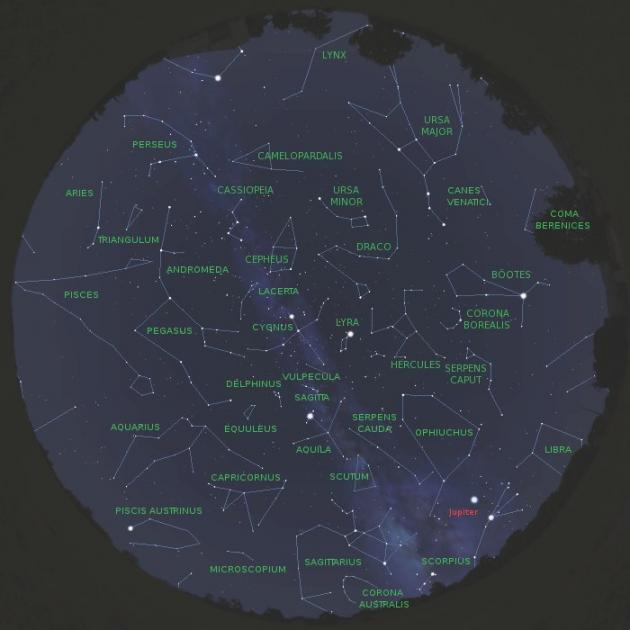- News / Thoughts
- Astronomy Guide
- On This Day
- Reviews
- Bookstore
Astronomical Events for September 2007
09/25/2007This month we are entering new season - autumn. Days will become much shorter and to the delight of amateur astronomers, nights will grow longer. Given that the evenings are still pretty warm, this is, for many amateurs, favorite time of year for backyard observing.
Planet wise, we are able to observe Jupiter for a few months now, but starting this month, Mars, the red planet, will start to emerge before midnight.
Also this month, there are two space missions planned. SELENE from Japan Space Agency, will explore the Moon, and the Dawn mission of NASA, will start it's journey toward asteroid belt. Both of these missions were planned to be launched two months ago, but because of found faults near launch time, or bad weather, or even political decisions, they were postponed for this month.
O

Evening sky for the middle of September 2007. at 09:00 PM. The map is valid for northern hemisphere, especially positions near 45 degrees latitude.
For the last few months, watching Jupiter, and it's biggest moons, sliding relatively low near horizon didn't give us very pleasing views. But starting this month, Mars will become observable too.
Even before midnight, Mars will start to climb on the eastern horizon. It has distinctively red color, so you'll be able to recognize it easily. Although Mars is quite close to Earth, taking planetary scale into account, it's size is only half of our planet. Given this circumstances, you'll have to use high magnification on your telescope to resolve any detail on it. Mars is the only planet on which we can observe surface characteristics. You'll thus be able to see major surface features, as well as changes on it's poles as the Mars seasons change.
This month we're entering autumn season. The moment when we switch from summer to autumn season is when the Earth is positioned in relation to Sun in a way that we have equal length of day and night - Equinox. This year the date for equinox is September 23. at 09:51 UT. On that day, Sun will rise exactly on East, and set exactly on West.
You can use this fact for educating children or friends. On the day of equinox you can mark the position of Sun at sunrise, and sunset, in your backyard or your porch, and those marks will directly point at East and West respectively. But, I can use compass too, you say... Well yes, and no. Compass uses Earths magnetic field, but that field isn't positioned directly at the poles, it doesn't run in a straight line, its strenght fluctuates over land, and even iron ore in the land can point the compass a few degrees off. So in some parts of our planet, compass is pointing in the wrong direction by few degrees.
Summer months in practical professional astronomy are usually used for fixing, cleaning or realuminizing telescopes, and often, because of weather predictability, for launching astronomical missions. Two months ago, two space missions were to be launched: SELENE, of Japan Space Agency (JAXA), and Dawn mission, from NASA.
o
O

Launch of SELENE satellite towards our Moon. Image credit: Mitsubishi Heavy Industries, Ltd. and the Japan Aerospace Exploration Agency (JAXA)
A few days before launch of SELENE mission, some faults were found, and the launching was postponed for this month. On the other hand NASA's Dawn mission was delayed because of bad weather, and then postponed for two months because Phoenix mission, launched last month, had greater priority.
SELENE was successfully launched on September 14, at 01:31 UT, and started towards our Moon, where it'll explore origin and history of changes of it. It's the biggest Moon mission since NASAs Apollo missions. To further promote this mission Japan Space Agency (JAXA) gave the opportunity to anyone to write a message for future generations.
American Dawn mission, which was more throughly described two months ago, is scheduled to be launched on September 27, if weather allows. It'll speed towards asteroid belt, where it'll explore dwarf planet Ceres, and Vesta asteroid, in hope that it'll shed some light on creation of our solar system, when this area around young Sun was filled with objects of similar size and composition.
We'll end this months review with moon phases for September 2007:
- Last Quarter - September 4. 02:33 UT
- New Moon - September 11. 12:44 UT
- First Quarter - September 19. 16:48 UT
- Full Moon - September 26. 19:45 UT